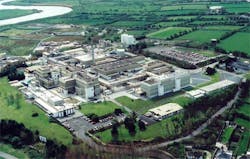Reduced waste and increased environmental responsibility make good business sense and contribute to a company’s long-term health and stability. But often “green” process changes come as a welcome by-product of overall process efficiency improvements.
Such was the case with Roche Ireland Ltd., whose process development specialists combined two processes into a single, more environmentally friendly process, which is now used to manufacture a key active pharmaceutical ingredient (API) at its Clarecastle facility. Among other things, the redesigned process increased yield. It also reduced solvent and steam use, as well as the generation of solid waste, all by 60%.
The process is being used to manufacture mycophenolate mofetil (MMF), the active ingredient in the Cellcept immune-system suppressant given to transplant patients to prevent rejection of a new organ. It recently won a Cleaner Technologies Award in an annual competition sponsored by the Irish Business and Employers Confederation (IBEC).
Roche had previously made MMF via a two-step process. First, it would purify technical-grade mycophenolic acid (MPA), a product of fermentation, using a process involving hot filtrations and extractions before crystallizing, isolating and drying the product. In the second process, the pure MPA was converted to MMF.
The older process had limited the facility’s ability to manufacture the drug. “We were concerned that rapid growth in demand for MMF would outstrip our ability to manufacture the API,” said Dennis Smith, Technical Services Director.
Process development chemists on Smith’s team then got to work. A cross-functional team at Clarecastle, including individuals from technical services, QA, QC, and the environmental, health and safety department redesigned the process, with support from regulatory experts at Roche’s Basel, Switzerland headquarters.
When they were finished, MMF production could take place in one step: A carefully designed series of processes removes fermentation by-products, and the resulting purified solution of MPA is used directly in the MMF process. The new purification process eliminates the need for isolation and drying, and all MPA is used in the reaction to produce MMF.
The team designed the new process and piloted it successfully in 2002, conducting trials at lab, pilot and full production scale before committing to full implementation, Smith says. In addition, the team analyzed and developed contingencies for all possible risks. For instance, an option was included in case emulsions should form during manufacturing, and was included in the regulatory filings before implementation.
The site received funding to implement the process alterations and began full production in 2005. Careful planning and prefabricating outside the plant whenever possible kept shutdowns to a minimum while the change in processes was made, Smith says.
So far, Roche has used the new process to produce over 200 tons of the API, and the benefits have been clear:
- A 2% yield increase during testing and an increase of more than 1% in early commercial production.
- Reduction in the quantity of solvent required from 55m3 to just 19 m3 per batch, or some 4,700 m3 annually.
- A 60% reduction in the amount of steam needed for solvent recovery.
- A 260 m3 per year reduction in the use of solvent for on-site incineration.
- A 60% drop in solid waste incineration, reducing by 100 tons the waste incinerated each year. The company now uses 2,400 fewer fiber packs for waste disposal each year.
- A 5% decrease in the amount of aqueous waste generated.
Roche has also found the new process to be much safer, as it requires significantly less cleaning, maintenance and offloading and recharging of product. The company says it recouped its $1 million investment in less than a year. More importantly, it significantly improved the production process of a billion-dollar product.
Achieved ROI in less than one year
“Manufacturing technicians are positive about the new process, which has eliminated some operationally challenging aspects of the older process, such as the series of hot filtrations that used to be required,” Smith says. In addition, it has catalyzed new ideas. “The manufacturing team members now have a number of other improvement ideas in the pipeline,” he says.
The change also required Roche to revamp its standard operating procedures and training materials. Training was divided into three parts: a detailed theoretical discussion of the new process, including why the change was made and what the anticipated benefits would be; hands-on practice; and a competency assessment to make sure that technicians understood their revised roles.
Can other processes be redesigned in a similar fashion? Roche’s process development specialists believe so. Purification is more efficient than the combination of crystallization, isolation and drying, says Technical Services Director Smith. Therefore, other processes that are typically used to purify a fermentation product also could be handled in this way.






